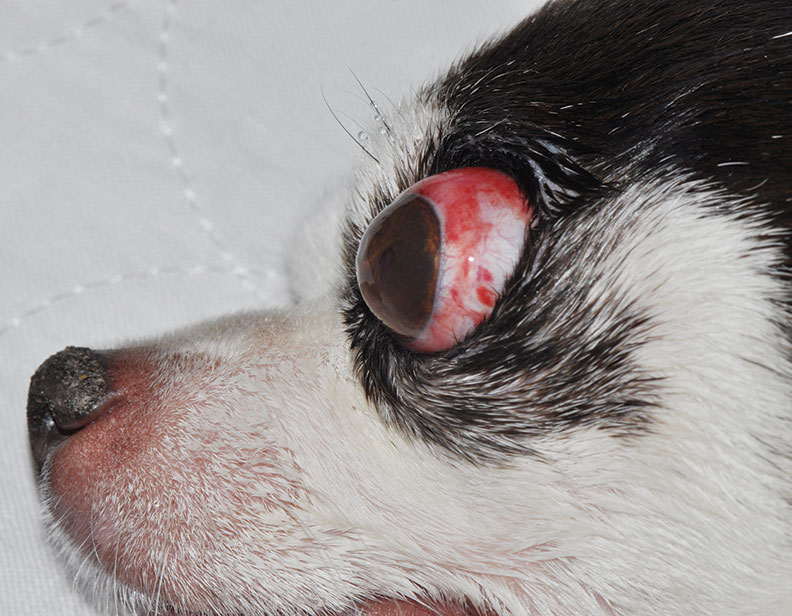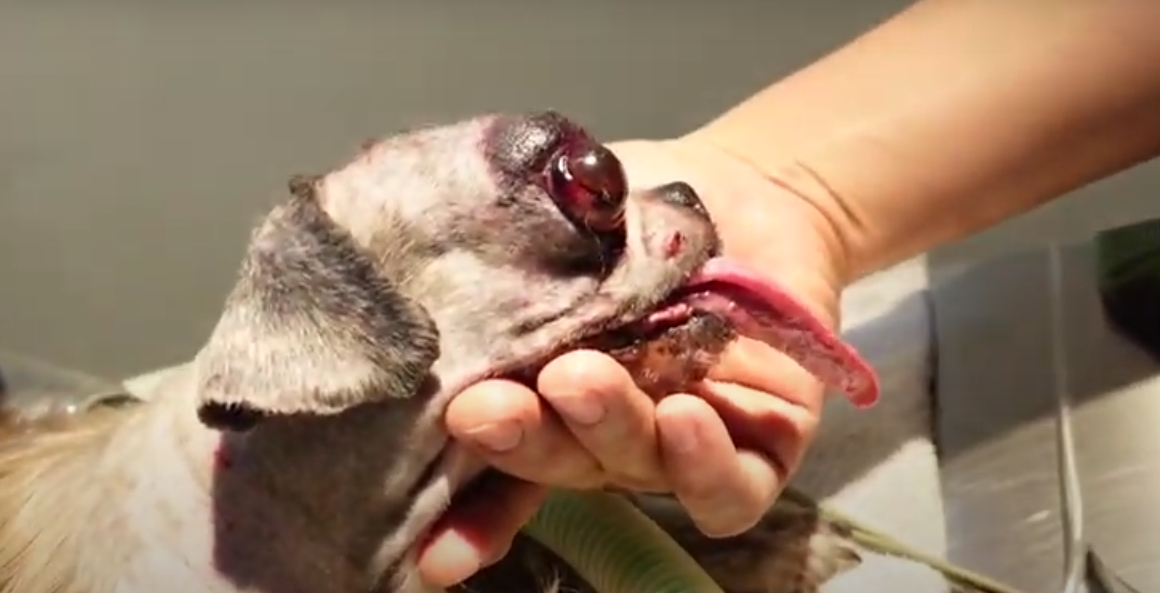Have you noticed your chihuahua’s eye-popping out lately? This usually happens that needs immediate action. One reason for this is because of the small face of your chihuahua. It is widely known that chihuahuas are very sensitive when it comes to taking care of its body. They are very fragile and susceptible to various health conditions. And without proper assessment and management, this eye protrusion can affect your chihuahua’s vision.
That is why in this blog, you will learn how to manage this condition and what to expect from the vet. So continue reading and tell your chihuahua stories below.
Causes And Signs Of Proptosis

There are various reasons why the eye of a chihuahua is popping out. This may be a cause of an infection, tumors, injuries, or traumas. In this section, we will focus more on the protruding eyes due to injury or trauma.
One severe case is Traumatic Proptosis. This is when the eye is displaced forward due to trauma. When the eye pops out, blindness can occur. This is because there is a congestion of the veins, inflammation, ulceration, and hemorrhage. To identify this case, observe the eyes of your chihuahua. Check if there is a sudden size abnormality in its pupil, inflammation and sticking out of the eyes and if you know your dog has been in a shock injury lately.
Diagnosis And Types
There are two types of protrusion: Buphthalmia and Exophthalmia.
👁️ Buphthalmos / Buphthalmia
In adult chihuahuas, buphthalmos is the only indication for chronic glaucoma, however, it is sometimes mistaken with exophthalmos. The eye is expanded in this condition but stays in its regular place inside the orbit. As a result, extra conjunctiva is rarely evident. In short, Buphthalmia is bulging of the eye but still in its original place making the conjunctiva invisible.
👁️ Exophthalmos / Exophthalmia
Exophthalmos is a condition in which the eye bursts outside the socket. This is characterized as proptosis and requires a thorough assessment by a veterinarian. This is quite painful, and you should take your chihuahua to the clinic as soon as symptoms appear.
What To Do As An Owner
Before going to the vet, you must know how to manage this condition. This is to avoid further complications and discomfort to your chihuahua.
✅ Don’t panic
If you have noticed the signs of proptosis, try to stay calm. This is to prevent complications that may happen due to unwanted movements. Remember that your chihuahua is very sensitive during this case, so don’t make your dog feel uncomfortable.
✅ Cover the eye
This is the most important thing that you must do as an owner. Clean your hands then damp a sterilized gauze or cloth and cover your dog’s eye. Use the saline solution as much as possible and choose water if it is your last resort.
Covering the eye with a damp cloth is very important to prevent getting your dog lots of infection. This step will also help ease the pain and make the healing process fast. Once you covered the affected eye, do not try to remove it once again just to add moisture. Let the gauze stay on its eye to avoid contamination.
✅ Push the eye
This step is very dangerous and is only advisable if the vet clinic is too far and the time is ticking. This is also only advisable if the eye is still slightly in place. So to do this, open the eyelids and push the eye very gently. But! If the eye is already inflamed, this step is not totally possible to do as it will only worsen the case.
What To Expect On Vet Clinic

Once you arrived at the vet clinic, you must also be aware of are the procedures that the vet doctor will do to your chihuahua. So that you won’t feel anxious about your dog’s situation.
👁️ Lubricants
Lather generous amounts of eye lubricant on the affected eye upon presentation. This lubricant can ease the pain by reducing friction whenever your chihuahua moves. It may also have an anti-inflammatory component to minimize the redness and discomfort.
👁️ Pain reliever
The vet will administer systemic analgesia because this condition is very sensitive. Your chihuahua will feel pain every time you touch the surroundings of its affected eye.
👁️ General assessment
The vet will assess your chihuahua’s general physical condition and check for some traumatic injuries. You will be also asked if your chihuahua has been into a dog fight or a traumatic accident.
👁️ Eye focus
After the general body assessment, it’s time to focus on your chihuahua’s eyes. In this step, the vet will check for the viability of the affected area. Things that need to be checked are structural damage such as in the cornea, and the vision reflexes using a light reflex.
👁️ Surgical management
The type of surgery will depend on the assessed viability of the prolapsed eye. An example of surgery is the globe replacement and this is done if there is still a chance of eye survival. This will include globe reduction and temporary tarsorrhaphy. However, if the eye area is already nonfunctional, removal of the globe is done.
Other Types Of Eye Disorder

Aside from proptosis, chihuahuas are very prone to various eye disorders. Because of their small facial features, their eyes are always affected during accidents. To avoid mismatching the signs and symptoms, here is the list of the possible eye disorders that your chihuahua can have.
✅ Pink eye
Pink eye is chihuahua is also known as conjunctivitis. It is usually diagnosed by detecting redness on the side or around the eye and the production of yellowish discharge. Pink eye is usually a cause of bacterial infection that is treated with eye drops. But in some cases, the redness goes away after hours if it is a cause of allergy.
✅ Damaged cornea
The cornea of a chihuahua can be damaged if there is debris trapped inside its eye. This debris is usually grass, stick, or rough dust that can bring irritation to the eyes. And once your chihuahua felt irritated, of course, it will rub its eye causing the debris to sting or prick the cornea. Another thing that can contribute to the damage is if your chihuahua has long nails and can poke its eyes while rubbing off the debris.
✅ Dry eyes
The medical term for chihuahua’s dry eyes is Keratoconjunctivitis sicca. This happens when the tear duct of your chihuahua does not produce tears because of a blockage. If the eyes are dry, it will cause more friction during blinking and will lead to irritation. This is also one cause why your chihuahua is having a hard time removing the debris in its eyes naturally. And if this is not treated immediately, it can cause scratches or ulcers in the eyes.
✅ Glaucoma
Glaucoma is rare in chihuahuas but it can happen. This occurs if the fluid in the eye is not properly drained causing excessive pressure and in severe cases, glaucoma can lead to blindness. To know if your chihuahua is suffering from glaucoma, you need to observe if there is a presence of excessive tearing, redness, cloudiness, dilated pupils, and eye-bulging of one eye.
✅ Cataracts
This is also a rare but possible eye problem in chihuahuas. The older your chihuahua, the higher the chance of occurrence of cataracts. Depending on the severity, chihuahuas with cataracts can still usually see unless the eyes are fully covered with cataracts.
The first to look for if your chihuahua has a cataract is cloudy eyes. This is because the cataract is usually mistaken with glaucoma especially if it is also associated with inflammation. Another sign that your dog is affected is if your chihuahua is adapting new movements due to sight adjustment. Such movements are bumping their heads accidentally, and continuous blinking.
✅ Cherry eye
This is very common to chihuahuas. Remember that dogs usually have three eyelids. The two eyelids are visible but the third eyelid is kept below the inner corner of the eye. The third eyelid is the home of the tear-producing gland and this is usually affected if there is a trauma that weakens the ligament that holds the eyelid. And if that ligament breaks, this is the time when the third eyelid comes into the picture. It is called cherry eye because it really looked like cherry when it popped out.
Bottom Line
Proper eye care is the first thing you must do. It is still possible to prevent these different eye disorders by protecting your chihuahua’s eyes in the first place. Because of its fragile body, you must protect it from different injuries that can lead to trauma and further complications. Also, consulting a vet is a must especially if you know that your chihuahua’s genes came from weak parents. You can remove the obstacles in your house where it can bump its head easily. So, regular check-ups and 100% focus on your chihuahua will prevent your dog from having serious health conditions.
Here at ILoveChihuahua, we share our personal experiences as owners of this feisty breed. We talk about recommended methods, dog supplies picks, and advice on common Chihuahua problems. Our goal is to promote responsible dog ownership, so there would be fewer Chihuahuas in shelters.


